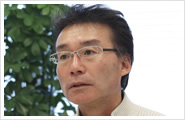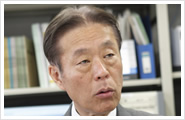My area of expertise is soil physics and environmental physics. Thus far I have been engaging in efforts to develop measuring methods for early detection of organic contaminants leaked into soil and to prevent contamination of groundwater.
Due to the nuclear power plant accident, the soil in surrounding areas was contaminated with radioactive cesium. I had hoped to come up with a way to apply my research up to that point to restore the cesium-contaminated soil, however, in reality, things were not so easy.
A research group was formed comprising researchers at Meiji University, University of Tokyo, and Shimane University to discuss how to reduce radiation levels. A method on how to decontaminate farm land that had been contaminated by cesium was also in our minds. However, upon visiting the actual contamination site in June, we realized that this method was merely a theory and nothing else.
First, we did not anticipate the contaminated area being situated deep in the mountains. I had originally imagined the area to be normal farmland on level ground, but actually the contaminated area was in a small area of level ground where produce is cultivated, nestled between some mountains. No matter how many times we decontaminate such a small area of farmland in the mountains, it would be a never-ending process, as contaminants would soon flow back again from the mountains behind it.
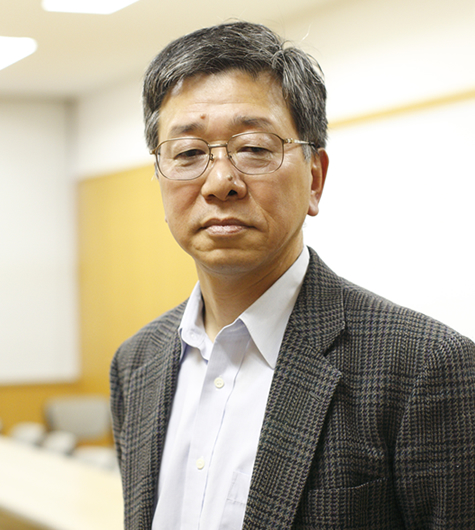
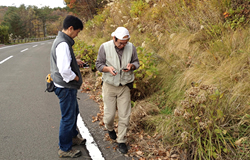
Therefore, we developed a new plan. The plan was to dig holes around the edges of the mountains and try to stave off the cesium there. We would dig vertical holes about several centimeters in diameter and 50 cm deep around the edges of the mountains and bury glass fiber there. Water contaminated by cesium would flow down the mountains into the holes and be guided underground by the glass fiber. This should reduce the level of radiation on the surface. This idea was adopted by Meiji University as an earthquake reconstruction project.
However, upon arriving at the contaminated site, this idea too turned out to be unrealistic. Clearing the trees, digging holes, and filling them with glass fiber would take up incalculable time and effort.
Therefore, we considered a method to dig, not holes, but ditches around the mountains to gather water. In this way, we might prevent recontamination of decontaminated land around the center of the flatland area, away from the mountains. However, there were houses that were built near the edges of the mountains, and after considering whether these houses would remain livable, this idea was also deemed not realistic.
There were still more unanticipated issues.
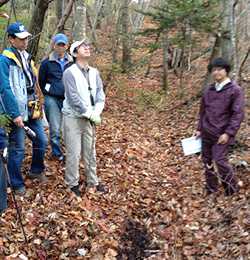
It was reported that after removing fallen leaves from the mountains, radiation levels in that area fell immediately. This meant that cesium in the atmosphere had fallen on the leaves that covered the surface of the mountains. Therefore, raking the fallen leaves would have a temporary effect on lowering radiation levels. However, cesium does not bond to fallen leaves. In other words, the cesium was merely on the leaves in a water soluble form. This meant that while we could collect the cesium that just happened to be on the fallen leaves we raked, the cesium on the leaves still left on the mountains would dissolve into water when it rained, sinking into the surface and flowing underground. Of course, there was no way to rake up all the leaves in the mountains—and if we could, there would still be the following problem.
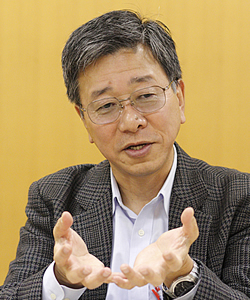
The fallen leaves that were raked up as samples to investigate for decontamination were placed into bags and gathered in one place. However, high radiation levels were detected in the place the leaves were gathered. Becoming alarmed, we took just one bag of leaves to take back for further analysis, but the bag by itself did not show a high level of radiation. It was simple addition. The more bags of leaves there were, the higher the level of radiation. If you think about it, it is only natural, but it came as a surprise to us researchers upon actually experiencing it. You can easily imagine how high radiation levels could get if we gathered all of the fallen leaves on the mountains.
Even so, we held an optimistic view that even if decontamination proved difficult, the effect of cesium on produce would naturally disappear in a few years. One of the properties of cesium is to bond to clay. Therefore, we believed that even if the cesium were to remain in the soil, in a few years it would bond to clay and not be absorbed by produce.
However, looking at the results of our survey, we found that the speed with which cesium bonds to clay was actually a lot slower than we had theorized. In reality, there was a possibility that it would not bond as much as we had anticipated, and we could not sit around waiting for cesium to naturally bond to clay.
Because our previous plan to channel cesium-contaminated water into the ground was also based on the theory that cesium would bond to clay underground and not contaminate groundwater, we needed to further our investigations. The cesium that was on the fallen leaves would dissolve in water when it rained, and some of that water would remain in the soil without bonding to clay. Eventually, that cesium might flow into the fields or contaminate groundwater.
In fact, in places where there was grass or moss near ditches by the side of the road in which water from the mountains gathered, we recorded higher levels of radiation than in other places. These areas were storing concentrated levels of cesium.
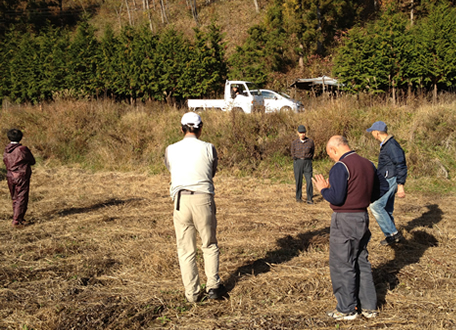
Currently, our research group visits the site every week, along with the Fukushima Saisei no Kai (Fukushima revitalization group) comprising mainly University of Tokyo alumni, to set radiation level gauges in various places. By continuing to monitor the gauges, we will be able to find out the speed with which radiation levels are diminishing naturally. Through these activities, we should be able to make an estimate on how many years it would take before life can return to the way it was before.
At present, we have yet to find a way to speedily restore the cesium-contaminated soil. However, if only to be able to present a forecast for disaster victims, we will continue with our research.
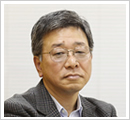
- Kosuke Noborio
-
Department/ School Professor, Department of Agriculture, School of Agriculture (Laboratory of Land Resources) Bio Dean, Meiji University Graduate School of Agriculture (2010-2012);
Councilor, Institute of Soil Physics (2009-2011, 2011-2013);
Director, Soil Physics Research Division, The Japanese Society of Irrigation, Drainage and Rural Engineering (2009-2011)Degree Ph.D., Texas A&M University (http://www.tamu.edu/) Research themes Soil Physics / Environmental Physics










